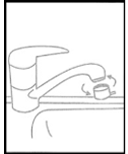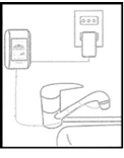
Ozono TherapyTM is a Medical device to produce ozone. Ozono TherapyTM allows to enrich water with ozone where to restore the active ingredients of potassium peroxymonosulphate sulphate and sodium percarbonate, consistently improving their biocide efficacy and leading to:


Ozono TherapyTM is easily installed in a few minutes on the water tap, thus providing for the immediate ozone production.
When opening the tap, ozone is produced according to the out-coming water quantity.
Thus Ozono TherapyTM turns out to be versatile and suitable for professional and domestic ambiences as well, being safe and offering an immediate benefit.
INSTALLATION INSTRUCTIONS



Ozone (O3), discovered between late 18th and early 19th century, is an unstable substance which is derived from elemental oxygen and appears in the form of a highly reactive, bluish aerial gas with a peculiar pungent smell, identical to the one which permeates the air during a rainstorm.
Its high reactivity makes this substance unstable, thus it should be produced immediately before use. After performing its function, and thanks to this very same peculiarity, it tends to revert rapidly back into oxygen without leaving any residues. These properties give it a higher value compared to other sanitising agents used to make drinkable water.
Since it derives from oxygen, ozone can attack harmful substances found in the water and convert them into harmless products, thus making water drinkable. It can perform this function even better than oxygen itself and other similar substances, because its oxidising power is far higher, thus acting more rapidly and more efficiently.
REGULATIONS
The FDA, a federal agency of the United States Department of Health and Human Services, allows the use of ozone as an antimicrobial agent in the gaseous phase or in aqueous solution within the production processes (treatment, processing, and storage) of foods, including meat, eggs, fish, cheese, fruits, and vegetables, thus validating ozone compatibility with human activities. In particular, Document 21 CFR part 173.368 (Docket No. 00F-1482) has defined ozone as a GRAS (Generally Recognized As Safe) substance, i.e. a secondary direct food additive which is safe for human health.
The EPA (Environmental Protection Agency) recognizes the efficacy of ozone and its higher oxidising power compared to chlorine and UV radiations, while showing minor contact times and the lack of micro-organism regrowth following the ozonation treatment.
In 2003, even the European Community introduced the use of food-grade ozone for disinfection and sterilization in water bottling processes. The Italian Health Ministry issued Protocol No. 24482 on 31st July, 1996, which recognized the use of ozone in air and water treatment as an approved product for sterilization of environments contaminated by bacteria, viruses, spores, moulds and mites.
OZONE EFFICACY
Ozone is one of the strongest natural oxidants, acting in concentrations of fractions of ppm (parts per million) in a relatively short time.
Table 1: Inactivation of bacteria, viruses, moulds, fungi and insects after ozonation in water
| ORGANISM | CONCENTRATION | EXPOSITION TIME |
|---|---|---|
(E. Coli, Legionella, Mycobacterium, Fecal Streptococcus) |
0,23 ppm – 2,2 ppm | < 20 minutes |
| VIRUS (Polivirus type-1, Human Rotavirus, Enteric virus) |
0,2 ppm – 4,1 ppm | < 20 minutes |
| MOLDS (Aspergillus Niger, vari ceppi di penicillum, Cladosporium |
2 ppm | 60 minutes |
| FUNGI (Candida Parapsilosis, Candida Tropicalis |
0,02 ppm – 0,26 ppm | < 1,67 minutes |
| INSECTS (Acarus Siro, Tyrophagus Casei, Tyrophagus Putrescientiae) |
1,5 ppm – 2 ppm | 30 minutes |
Ozone has been recognised worldwide as a safe substance for sanitation procedures, and it stands out from among any other disinfectants because of the following properties:
Table 2: Ct values for virus inactivation by several disinfectants
| DISINFECTANT | UNIT | INACTIVATION | ||
|---|---|---|---|---|
| Chlorine | mg∙min/L | 3 | 4 | 6 |
| Chloramine | mg∙min/L | 643 | 1.067 | 1.491 |
| Chlorine dioxide | mg∙min/L | 4,2 | 12,8 | 25,1 |
| Ozone | mg∙min/L | 0,5 | 0,8 | 1,0 |
| UV | mg∙min/L | 21 | 36 | N/A |
Ct values drawn from AWWA 1991 (American Water Works Association).
Table 3 shows instead the disinfection rate for Giardia spores. As it may be noticed, chlorine and chloramine have higher Ct values than ozone. This means that ozone is a strong disinfectant, surely better than other sanitising agents commonly used to inactivate this kind of micro-organism.
Table 3: Ct values for the inactivation of Giardia cysts by several disinfectants
| DISINFECTANT | INACTIVATION (mg∙min/L) | |||||
|---|---|---|---|---|---|---|
| 0,5-log | 1-log | 1,5-log | 2-log | 2,5-log | 3-log | |
| Chlorine2 | 17 | 35 | 52 | 69 | 87 | 104 |
| Chloramine3 | 310 | 615 | 930 | 1.230 | 1.540 | 1.850 |
| Chlorine dioxide4 | 4 | 7,7 | 12 | 15 | 19 | 23 |
| Ozone | 0,23 | 0,48 | 0,72 | 0,95 | 1,2 | 1,43 |
Ct values drawn from AWWA 1991 (American Water Works Association).
SANITISING FORMULA IN OZONATED WATER
Ozone is an aerial gas which is soluble in aqueous solution (up to 13 times more than oxygen at a temperature of 32 to 86°F), with an inversely proportional solubility with respect to temperature and pH. Taking advantage of this characteristic and tackling the issue of its relatively short duration (ozone tends to be decomposed quickly into oxygen without leaving any harmful residuals in the environment), we have created Ozono TherapyTM, a water ozonator distributed exclusively by Biosteril Italia srl designed to generate a controlled ozone flow which, blended into mains water, cuts down limitations to its accessibility.